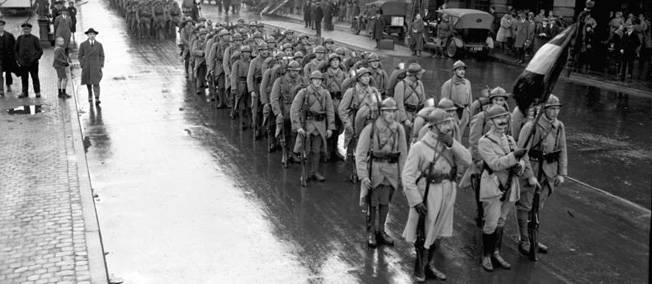The Beer Hall Putsch

On November 8-9, 1923, Adolf Hitler and the Nazi Party, a group of two thousand Nazis, marched on the Feldherrnhalle in the city centre, intending to overthrow the German government. This failed coup d’état came to be known as the Beer Hall Putsch.
A Climate of Instability
All through Germany, the initial four years of the Weimar Republic were marred by financial woes, trauma at the loss of World War I, and embarrassment at what many viewed as the unnecessarily brutal terms of the Versailles Treaty.
In this environment of turmoil, both left and right-wing political forces attempted and failed to overthrow the fledgling democracy.
In 1923, in response to German inability to pay compensations under the Treaty of Versailles, France and Belgium occupied Ruhr in Germany, a large portion of which lay across the river on the east bank of the Rhine, until 1925. Numerous Germans were killed during civil disobedience protests. In addition, mass dissatisfaction was triggered due to the hyperinflation that had taken a toll on the German economy.
Hitler was also highly inspired by Benito Mussolini’s “March on Rome” that happened in October 1922 which resulted in Benito Mussolini’s National Fascist Party (PNF) ascending to power in Italy.
In March 1920, the event of Kapp’s putsch had also taken place that aimed to undo the German revolution of 1918-19, overthrow the Weimar Republic and establish an autocratic government. Although the legitimate German Government fled the city for a few days, the coup failed after a few days. All these cases acted as a precedent for Hitler.

Image Source: The History Place
The contention between Bavaria and Berlin intensified when the Reich chancellor, Gustav Stresemann called off the passive resistance to the Ruhr occupation. An objection in Bavaria prompted Knilling to appoint (without discussion with the Reich specialists) Kahr as a Bavarian state commissioner (Generalstaatskommissar) with dictatorial powers. Kahr incited the local Reich army commandant, Gen. Otto von Lossow, to decline to carry out an order for his bosses in Berlin to take measures against the Nazi Party. The Bavarian government attempted to confine the military corps in Bavaria from its allegiance to the Reich by assuming authority over it.
Gustav Ritter von Kahrwas a German right-wing politician actively working in Bavaria. He assisted in transforming post-World War I Bavaria into Germany’s pivotal point of extremist nationalism but was instrumental in suppressing Adolf Hitler’s Beer Hall Putsch in 1923.
Kahr studied law and functioned as a legal counsel before entering politics. He served Bavaria’s House of Wittelsbach faithfully, endeavours that procured him the title, Ritter. Politically, he was a monarchist and connected to the Catholic Bavarian People’s Party (BVP). However, he was a Protestant and never joined any party.

Image Source: Wikipedia
Ludendorff, a World War I general who had gone through the postwar years engendering the myth that his militaries had been “stabbed in the back” by German politicians, had partaken in the Kapp Putsch and hence laid down a good foundation for himself in Bavaria. There he became related to the National opportunity for another coup attempt could be at hand.
The Putsch
In October 1922, Hitler and his partners wanted to involve Munich as a base for a protest Germany’s Weimar Republic government. However, conditions varied from those in Italy. Hitler concluded that Kahr wanted to control him and was not prepared to act against the government in Berlin. Hitler needed to seize an essential opportunity quickly for successful popular agitation and support. He chose to assume control over issues. With a large separation of SA, Hitler walked on the Bürgerbräukeller, where Kahr delivered a speech before 3,000 individuals.

Image Source: Holocaust Encyclopedia
The following day, the 9th of November 1923, Hitler drove a demonstration through the roads of Munich, planning to take command over the war ministry building. Hitler, surrounded by his associates Hermann Göring, Alfred Rosenberg, Rudolf Hess, Ernst Hanfstaengl, Ulrich Graf, Johann Aigner, Adolf Lenk, Max Amann, Max Erwin von Scheibner-Richter, Wilhelm Adam, Robert Wagner, and others (some 20 in all), advanced through the crowded auditorium.
Von Kahr gave his support to Hitler at gunpoint. But when Hitler left to figure out a conflict between the SA and troops, he withdrew his support, moved the Bavarian government, and proclaimed the Nazi Party a banned association.
Armed police obstructed their course, and firing broke out. Fourteen Nazis and four policemen were killed. Hilter fell to the ground as soon as the firing started. He suffered sharp pains, and he assumed that he was wounded, but later, he found that it came from a dislocated shoulder. According to Page 74 of The rise and fall of the Third Reich by William L Shirer, Hitler “was the first to get up and turn back”, leaving his dead and wounded comrades lying on the street.
Hitler came close to being killed but fled the scene only to be arrested two days later, on the 11th of November 1923. The putsch failed, and Bavarian authorities prosecuted nine members, including Hitler. But, notwithstanding its disappointment, the Nazi leaders, at last, redefined the putsch as a heroic work to save the country.
Hitler’s Trial
The putsch brought Hitler to the German country’s attention for the first time and made it to the headlines in papers all over the planet. A 24-day trial followed his capture and gave him a stage to communicate his feelings to the country. At the trial, he issued an almost four-hour opening statement that stunned spectators. He started by recounting his life story and then moved to his political vision. He was unsparing in his criticism of racial minorities and left-wing philosophies, referring to Communists as “not even human.” He faulted the government in Berlin for the economic crisis, saying it had “basically ransacked [the people] of their last marks from their pockets.”

Image Source : The History Place
Hitler got only a five-year sentence for felony. Hitler was accused of conspiracy and sentenced to five years in Landsberg Prison, where he composed Mein Kampf by directing to other prisoners, Emil Maurice, and Rudolf Hess. After serving just nine months, Hitler was released on the 20th of December 1924. Once released, Hitler diverted his focus towards acquiring power through lawful means instead of by revolution or power; his strategies further developed Nazi propaganda.
The Putsch Became a Memorial for the Nazi Regime
The unsuccessful putsch gave Hitler overall fame but also drove him to choose to achieve power by more conventional means. Hitler got his payback against Kahr when he had him killed during the Night of the Long Knives (the 30th of June 1934).
Hitler and the Nazi Party cultivated the memory of the putsch. They gave it an exceptional place in the story of the Nazi movement and ultimately in that of the German state.
After Hitler got into power, Nazi Germany observed the 9th of November as Reich Day of Mourning (Reichstrauertag).
When we think about such past events, we think about how different the path of history had been if few things had gone the other way.
What if the firing had taken Hitler out? What would have happened if he got a harsher sentence for treason?
The highest penalty in Bavaria for treason was the death penalty (he got only five years).
He didn’t even serve five years and got out in nine months. All these collectively gave Hitler a second lease of life.
Reflecting that any of the above could have meant world history could have gone on a very different path.
Source:
French and Belgium troops occupy the Ruhr region in 1923 (Header Image): MR Allsop History
